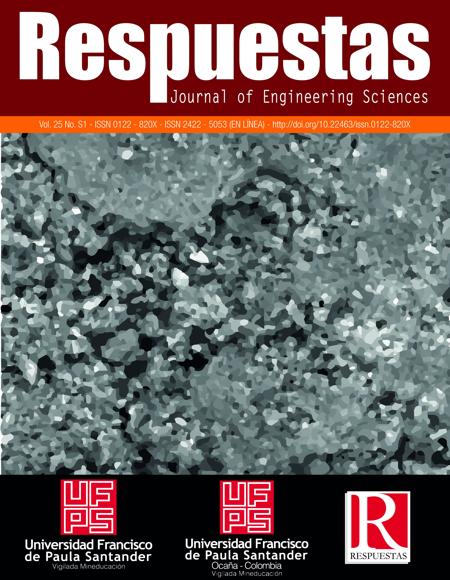Thermal and technical characterization of multi-perforated brick at the laboratory level
Caracterización térmica y técnica del ladrillo multiperforado a nivel de laboratorio
Main Article Content
The ceramics industry in Norte de Santander is recognized for the quality of the raw material that the products offer. However, the guild has limited itself to the mass production of units to satisfy the construction market, leaving aside research and innovation fields to develop new proposals. The characterization of multiperforated brick MB at laboratory level is a thermal and technical referent of a conventional product and positioned in the construction world. The product was developed on a laboratory scale by extrusion in clay and coffee dust in the CIMAC Ceramic Materials Research Center from the Francisco de Paula Santander University, in order to characterize the MB physical and mechanical properties such as linear contraction, mass losses, determination of efflorescence, resistance to compression, dimensions, water absorption, initial rate of capillarity, porosity and apparent specific weight at the laboratory level. In parallel, it was validated
thermally through simulations using the finite element method performed in the ANSYS R16 software to identify the energy behavior by transfer and heat fluxes. This research is the starting point for future projects focused on the design of ceramic products. The results provide technical and thermal data to develop new
innovative products that contribute to sustainability.
Downloads
Article Details
L. Muniz, C. Cotrim, M. Henriques y L. Moreira, «Eficiência térmica de materiais de cobertura,» Ambiente Construido, vol. 18, nº 1, pp. 503-518, 2018.
K. Johnsen y F. Winther, «Dynamic facades, the smart way of meeting the energy requirements,» Energy Procedia, vol. 78, pp. 1568-1573, 2015. [3] ICONTEC, NORMA TECNICA COLOMBIANA NTC 4205, 2017.
CISBE , Guide A: Environmental design, vol. Chapter 3: Thermal properties of building structures, 2007.
A. Garcia, «Aislamiento, bienestar y ahorro de energia,» Informes de la construccion, vol. 28, nº 277, pp. 35-54, 1976.
A. Sarabia, J. Sanchez y J. C. Leyva, «Uso de nutrientes tecnológicos como materia prima en la fabricación de materiales de construcción en el paradigma de la economía circular,» Respuestas, vol. 22, nº 1, pp. 6-16, 2017.
J. L. Amoros, E. Sanchez, J. Garcia-Ten, V. Sanz y M. Monzo, Manual para el control de la calidad de materias primas arcillosas, 2 Edicion, Instituto de Tecnologia Ceramica ITC, 2004, pp. 121-122.
ICONTEC, NORMA TECNICA COLOMBIANA NTC 4017, 2018.
R. Fombella, «Eflorescencias en las fachadas de ladrillo cara vista,» NA: nueva arquitectura con arcilla cocida, nº 5, pp. 55-62, 1997.
UNE Normalizacion Española, UNE-EN 772-11:2011 Métodos de ensayo de piezas para fábrica de albañilería., 2011.
UNE Normalizacion Española, UNE-EN 772- 21:2011 Métodos de ensayo de piezas para fábricas de albañilería., 2011.
ASTM International, ASTM C373, 2018.
J. Sanchez, A. Sarabia y D. Alvarez, «Evaluación de materias primas utilizadas en la fabricación de baldosas de gres en el sector cerámico de Norte de Santander (Colombia),» Respuestas, vol. 21, nº 2, pp. 48-56, 2016.
IDEAM, «Atlas Interactivo de Colombia,» 2010. [En línea]. Available: http://atlas.ideam.gov.co/.
W. Bustamante, A. Bobadilla, B. Navarrete, G. Saelzer y S. Vidal, «Uso eficiente de la energia en edificios habitacionales. Mejoramiento termico de muros de albañileria de ladrillos ceramicos. El caso de Chile,» Revista de la Construccion, vol. 4, nº 2, pp. 5-12, 2005.
M. &. N. J. Niño.Norte de Santander, Colombia Patente 30561, 2015.
V. Marincionia, N. May y H. Medina, «Parametric study on the impact of thermal bridges on the heat loss of internally insulated buildings,» Energy Procedia, vol. 78, pp. 889-894, 2015.
L. Dumitrescu, I. Baran y R. Pescaru, «The influence of thermal bridges in the process of buildings thermal rehabilitation,» Procedia Engineering, vol. 181, pp. 682-689, 2017.
N. Arias y A. Bobadilla, «Evaluacion experimental y analisis de la mejora con aislamiento termico para el caso de puente termico en el frente de forjado,» Informes de la construccion, vol. 69, nº 546, pp. 1-14, 2017.
M. &. N. J. Fuente Niño.Norte de Santander, Colombia Patente 30561, 2015.
E. Garcia y M. Suarez, Las arcillas: Propiedades y usos, Universidad Complutense (Madrid), Universidad de Salamanca, 2004.
K. Johnsen y F. Winther, «Dynamic facades, the smart way of meeting the energy requirements,» Energy Procedia, vol. 78, pp. 1568-1573, 2015.
R. Bassiouny, M. Ali y E. NourEldenn, «Modeling the Thermal Behavior of Egyptian Perforated Masonry Red Brick Filled with Material of Low Thermal Conductivity,» Journal of Building Engineering, pp. 1-22, 2015.


